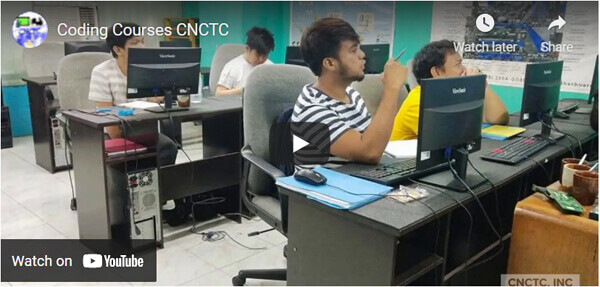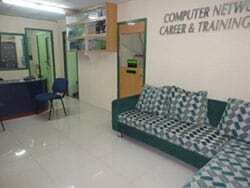
Key Features
- 3 days Instructor-Led Live Online Classroom
- Live Webex Virtual Class in Learning Management System
- Access to Remote Lab PC for Hands-On activities
- Unlimited Practice exams
- Integrated Courseware in the Learning Management System
- Step by Step guide for challenging hands-on lab activities
- Flexible Schedules – Both Weekdays and Weekends Classes
- Get Trained by Systems Analysis and Design Expert Trainer with Over 15 Years of Industry Experience
- No. 1 Training Center for Systems Analysis and Design Courses
- E-learning Access for Pre-course and Post Training Support
- Best Price Guaranteed for Systems Analysis and Design Courses
Key Features
- 3 days Instructor-Led Face to Face Classroom training
- We are a TESDA Registered Training Center
- Offering Flexible Schedules – Both Weekdays and Weekends Classes
- Get Trained by Systems Analysis and Design Expert Instructor with Over 15 Years of Industry Experience
- No. 1 Training Center for Systems Analysis and Design Courses
- We Guarantee Best Price for Systems Analysis and Design Courses
Key Features
- Gain the technical skills needed in the workplace. 1 on 1 training is the best way to learn
- Quickest way to master any of our course offerings.
- Experience superb hands-on laboratory activities and unobstructed attention from your trainer.
- Guaranteed to start the Training
TRAINEE FEEDBACKS
COURSE DESCRIPTION:
Systems Analysis and Design discusses a practical, streamlined, and updated approach to information systems development. The course emphasizes the role of the systems analysts in a dynamic, business-related environment.
In this course, students learn how to translate business requirements into information systems that support a company’s short- and long- term objectives. Case studies and discussions teach analytical reasoning, critical thinking and problem-solving skills.
COURSE OBJECTIVES:
- Explain systems analysis and design
- Introduce project management concepts early in the systems development process, and explains project management tools and techniques.
- Challenge students with Question of Ethics mini-case in each chapter that asks them to respond to real-life ethical issues in an IT environment.
- Provide multi-method coverage, including a comparison of structured, object-oriented and agile systems development methods.
- Explain how IT supports business requirements in today’s intensely competitive environment, and describe major IT developments and
ENTRY REQUIREMENTS:
Working knowledge in any programming language.
EMPLOYMENT OBJECTIVES
Upon completion of the course, students will be qualified to be a Software developer, Systems Analyst or IT systems manager.
SAD Syllabus
Chapter 1: SYSTEMS PLANNING
Introduction to Systems Analysis and Design
- Introduction
- What is Information Technology?
- Information System Components
- Business Today
- Modelling Business Operations
- Business Information Systems
- What Information Do Users Need?
- Systems Development Tools
- Systems Development Methods
- The Information Technology Department
- The Systems Analyst
- Trends in Information Technology
Analyzing the Business Case
- Introduction
- A Framework for IT Systems Development
- What is a Business Case?
- Information Systems Projects
- Evaluation of Systems Requirements
- Overview of Feasibility
- Evaluating Feasibility
- Setting Priorities
- Preliminary Investigation Overview
Managing Systems Projects
- Introduction
- Overview of Project Management
- Creating a Work Breakdown Structure
- Identifying Task Patterns
- Calculating the Critical Path
- Project Monitoring and Control
- Reporting
- Project Management Examples
- Project Management Software
- Risk Management
- Managing for Success
- The Bottom Line
Chapter 2: SYSTEMS ANALYSIS
Requirement Modelling
- Introduction
- Systems Analysis Phase Overview
- Joint Application Development
- Rapid Application Development
- Agile Methods
- Modelling Tools and Techniques
- Systems Requirements Checklist
- Future Growth, Costs, and Benefits
- Fact-Finding
- Interviews
- Other Fact-Finding Techniques
- Documentation
- Information Management Software
- Preview of Logical Modelling
Data and Process Modelling
- Introduction
- Overview of Data and Process Modelling Tools
- Data Flow Diagram
- Creating a Set of DFDs
- Guidelines for Drawing DFDs
- Data Dictionary
- Process Description Tools
- Logical vs Physical Models
Object Modelling
- Introduction
- Overview of Object-Oriented Analysis
- Relationships Among Objects and Classes
- Object Modelling with the Unified Modelling Language
- Organizing the Object Model
Development Strategies
- Introduction
- Development Strategies Overview
- The Impact of the Internet
- Outsourcing
- In-House Software Development Options
- The Systems Analyst’s Role
- Analyzing Costs and Benefits
- The Software Acquisition Process
- Completion of Systems Analysis Tasks
- Transition to Systems Design
Chapter 3: SYSTEMS DESIGN
User Interface and Design
- Introduction
- Systems Design Phase Overview
- What is User Interface?
- Seven Habits of Successful Interface Designers
- Guidelines for User Interface Design
- Source Document and Form Design
- Printed Output
- Technology Issues
- Security and Control Issues
- Where Do We Go from Here?
Data Design
- Introduction
- Data Design Concepts
- DBMS Components
- Web-Based Design
- Data Design Terms
- Entity-Relationship Diagrams
- Data Normalization
- Two Real-World Examples
- Using Codes
- Data Storage and Access
- Data Control
System Architecture
- Introduction
- Architecture Checklist
- System Architecture: Then and Now
- Client-Server Designs
- The Impact of the Internet
- E-Commerce Architecture
- Processing Methods
- Network Models
- Wireless Networks
- Systems Design Completion
Chapter 4: SYSTEMS IMPLEMENTATION
Managing Systems Implementation
- Introduction
- Software Quality Assurance
- Overview of Application Development
- Structured Application Development
- Object-Oriented Application Development
- Agile Application Development
- Coding
- Testing the System
- Documentation
- Management Approval
- System Installation and Evaluation
- Operational and Test Environment
- Training
- Data Conversion
- System Changeover
- Post-Implementation Tasks
Chapter 5: SYSTEMS SUPPORT AND SECURITY
Managing Systems Support and Security
- Introduction
- User Support
- Maintenance Tasks
- Maintenance Management
- Systems Performance Management
- System Security Overview
- Security Levels
- Backup and Recovery
- System Obsolescence
- Future Challenges and Opportunities
COURSE FEE
COURSE SCHEDULES
3 days / 8am - 6pm (30hrs)

| Developing ASP.NET Core MVC Web Applications |
| Microsoft C#.NET 2015 |
| Microsoft VISUAL BASIC.NET 2015 |
| ASP.NET using C#.NET Programming |
Call Us for more information
Tel: (+632) 8285-2936 / (+632) 8736-2032
Smart: 09073576583 / 09993302327
Globe: 09776468236 / 09776932556
Request Course Quotation
Take advantage of CNCTC 's latest interactive Instructor-Led Live Online Training. Online Courses are delivered using WebEx to bring the classroom to your home or at your workplace and can be accessed directly on your own computer with an internet connection. By using Cisco’s WebEx, and integrating our Computer lab facilities, we can provide a near-classroom experience remotely to your own location of choice. Register Now!







